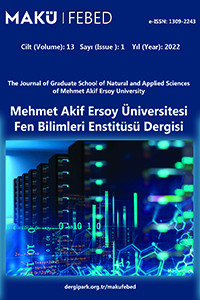İğde (Elaeagnus angustifolia L.)’nin Yetiştiği Toprakların Bazı Fiziksel ve Kimyasal Özellikleri ile Ağır Metal Durumunun Değerlendirilmesi: Erzurum Örneği
Ağır metaller, iğde, toprak fiziksel ve kimyasal özellik, kirlilik
Evaluation of Some Physical and Chemical Characteristic and Heavy Metal Status of Russian olive (Elaeagnus angustifolia L.)’s Soils: Case of Erzurum Province, Turkey
___
- Referans1 Alloway B.J. (1990). Heavy Metals in Soils, Blackie Galasgow, UK, 368p.
- Referans2 Anonim, (2005). Toprak Kirliliğinin Kontrolü Yönetmeliği. Bakanlık: Çevre ve Orman Bakanlığını, Kanun: 31/8/1983 tarihli ve 18132 sayılı Resmi Gazete
- Referans3 Bayar E. (2009). Erzurum şehir merkezindeki bazı kavşaklarda bitki (Pinus sylvestris) ve toprakların ağır metal (Fe, Cu, Zn, Mn, Cd, Pb ve Ni ) kontaminasyon durumunun belirlenmesi, Atatürk Üniversitesi. Fen Bil. Enst., Toprak Anabilim Dalı, Yüksek Lisans Tezi, s.66, Erzurum
- Referans4 Bilge U., Çimrin K.M. (2013). Viranşehir –Kızıltepe Karayolu Kenarındaki Topraklarda Motorlu Taşıtlardan kaynaklanan Ağır Metal Kirliliği, Tarım Bilimleri Dergisi, 19 (4), s; 323-329. Ankara.
- Referans5 Bouyoucos G.J. (1951). A Recalibration of hydrometer for marking mechanical analysis of soil, Agronomy Journal, 43; 434-438.
- Referans6 Dean J.G. Bosqui F.L., Lanouette V.H. (1972). Removing heavy metals from waste water: Environmental Science and Technology, 6, 518-522.
- Referans7 Haktanır K., Arcak S. (1998). Çevre Kirliliği. Ankara Üniversitesi. Ziraat Fakültesi, Ziraat Fak. Yay. No.1503, Ders kitabı: 457, Ankara
- Referans8 Herrick G., Freidl T. (1990). Patternsoftrace Metal Concentrationand Acidity in Mointain Forest Soils of Northeastern US, Water-Air-Soil Pollution, 53, 151-157.
- Referans9 Jackson M.L. (1967). Soil chemical analysis, Prentice-Hall of India Private Limited, 498p, NewDelhi.
- Referans10 Kabata-Pendias A., Pendias H. (1984). Trace Elements in Soils and Plants, 1st ed. CRC Press, Boca Raton, Florida, USA.
- Referans11 Kabata-Pendias A., Pendias H. (1989). Trace Elements in the Soil and Plants. CRC Press, Boca Raton, FL
- Referans12 Khan A.G. (2003). Vetiver grass as an Ideal Phytosymbiont for Glomalian Fungi for Ecological Restoration of Heavy Metal Contaminated Derelict Land. Proceedings of Third Internatioal Vetiver Conference (ICV-3), Guangzhou, China
- Referans13 Lindsay W.L., Norwell W.A. (1978). Development of a DTPA Soil Test for Zinc, Iron, Manganese and Copper., Soil Sci. Soc. Amer. J. 42: 421-428.
- Referans14 M., Melati R.M., Orecchio S. (2001). Assessment of the quality of the air in the city of Palermo through chemical and cell analyses on Pinus needles Atmospheric Environment 35: 6435-6445.
- Referans15 Marschner H. (1986). Mineral Nutrition of Higher Plants. Institute of Plant Nutrition, Hohenheim Federal. Republic Of Germany, Academic Press, London, 1983.
- Referans16 Mattigod S.V., Page A.L. (1983). Assesment of metal pollution in soils. Pages 355 - 394 in I. Thornton, Ed. Applied environmental geochemistry. Acedemic Press. London
- Referans17 Önder S., Dursun S., Gezgin S., Demirbaş A. (2007). Determination of Heavy Metal Pollution in Grass and Soil of City Centre Green Areas (Konya, Turkey), Polish J. of Environ. Stud.,16(1), 145-154.
- Referans18 Patterson J.B.E. (1971). Metal Toxicities Arising From Industry, p.193-207, In Trace Elements, In Soils and Crops. MAFFTechnical Bull., No.21, Her Majestr’sStationery Office, London
- Referans19 Prasad M.N.V.(1995). Cadmium Toxicity and Tolerance in Vascular Plants. Environmental Exp. Bot.35; 525-545
- Referans20 Reeves R.D., Brooks R.R. (1983). Hyperaccumulation of lead and zinc by two mettallophytes from a mine area in Central Europe, Environmental Pollution Seri A Ecological and Biological, 31(4): 277-285.
- Referans21Robert H.M. (1995). Contaminants in the Upper Mississippi River: Boston, Butterworth Publishers, 195-230
- Referans22 Salt D. (2001). Responses and adaptation of plants to metal stress . pp 159-179. In; Molecular Analaysis of Plant Adaptations to the Environment Hawkesford MJ (ed.) Kluwer Academic Publishers. Doerdrecht.
- Referans23 Schlichting E., Blume H.P. (1966). Bodenkundliches praktikum. Verlag Paul Paney, Hamburg und Berlin, pages 121–125.
- Referans24 Topbaş M.T., Brohi A.R., Karaman M.R. (1998). Çevre Kirliliği. T.C. Çevre Bakanlığı Yayınları. Ankara.
- Referans25 Yıldız N. (2001). Toprak Kirletici Bazı Ağır Metallerin (Zn, Cu, Cd, Pb, Co ve Ni) Belirlenmesinde Kullanılan Yöntemler. Atatürk Üniversitesi Ziraat Fakültesi Dergisi. 32 (2): 207-213 Erzurum.
- Yayın Aralığı: Yılda 2 Sayı
- Başlangıç: 2010
- Yayıncı: Burdur Mehmet Akif Ersoy Üniversitesi
Hicaznar Nar (Punica granatum L.) Çeşidinde İyi Tarım Uygulamaları (İTU)
Yeşil Yol Planlama: Denizli Pamukkale İlçesi Örneği
Murat ZENGİN, Duygu DOĞAN, Sinem ÖZDEDE
Çanakkale Kentsel Yapısına Eleştirel Bir Yaklaşım: Butik Kent
Sibel YORULMAZ SALMAN, Cenk KESKİN, Betül BAL, Mustafa Onur DÖNMEZ
Tuba Elif YAY, Bahadır ÖZEL, Selda TEKİN ÖZAN
İmmün Kontrol Noktası İnhibitörleri Ctla-4 ve Pd-1/Pd-l1’in İmmünoterapideki Yeri
Kübra KAHVECİ, Melisa TÜRKOĞLU
Binalarda Enerji Verimliliği Uygulamaları: MAKU Mühendislik Mimarlık Fakültesi Örneği
Çimento Esaslı Odun Kompozit Malzemelerin Üretim Prosesi ve Özellikleri Üzerine Bir Çalışma
Halil Turgut ŞAHİN, Ali İhsan KAYA, Ömer Ümit YALÇIN, Şemsettin KILINÇARSLAN, Yasemin ŞİMŞEK, George İ. MANTANİS
2.45 GHz Frekasında Optimum Bant Durduran Filtre Tasarımı ve Optimizasyonu
